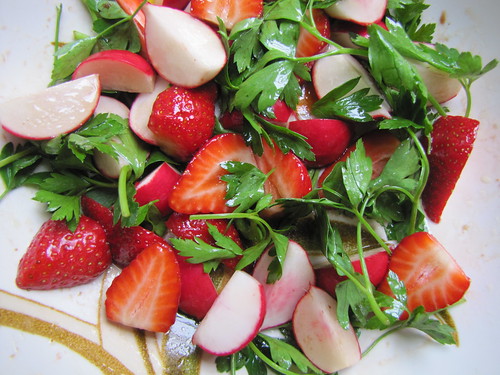Farm Update
 |
| Here are some of the green beans that Fred and the guys planted last week, which are likely to be ready in about a month. |
Hi everyone! Well, we've been crazy busy this last week at the farm, but we've reached the apex of insane workload, and we'll shortly begin our descent back into just the regular amount of crazy. Everything is growing quickly at the farm, including the weeds, so keeping up with them has been tricky. The blueberry patch looks healthy, and there are a lot of berries developing now that will be ready in a few weeks. In the orchard, there are also a lot of apples developing on the trees, so we should have a lot of them in the fall! However, we have had quite a bit of insect pressure on the apples, so we might be making them into cider due to the blemishes. The pigs are happy and growing, and they have been digging up their pasture quite a bit. The chickens are also doing well, and as far as we can tell, we haven't lost any more since the run-in with our neighbor's dog a few weeks ago. We've also been seeing a huge amount of garter snakes out at the farm lately, too! The snakes are actually great to have around, because they take care of the mice and other small animals that might otherwise be a problem. And we'll take organic pest control helpers in whatever form they come, whether the four-legged kind (like our dog, Josie) or the non-legged kind.
 |
| These lovely beets will be a choice in this week's share! |
What to Expect in This Week's Share
- Choice of regular cabbage or Napa cabbage
- Choice of beets or bok choy
- Choice of strawberries or snap peas
- Choice of spinach, broccoli, or a surprise veggie
- Choice of cilantro, dill, frisee, or kohlrabi
- Choice of kale, chard, or radishes
- Choice of salad mix or head lettuce
Veggie Spotlight: Cabbage
Cabbage has been recorded as being eaten since 1000 BC, but
like many vegetables, it has changed quite a bit over that time. The first cabbage
plants were thought to have originated in the cooler northern parts of Europe. These first
early cabbages were actually very loose and leafy, more similar to kale, and were
mentioned frequently in Roman writings. It was possibly as early as 200 BC that the heading types started to appear, but this
is still unclear. In medieval times, the cabbage was more associated with the European
peasants, who often used cabbage as one of their main foods. Because cabbage is generally hardier than most other crops, European peasants could count on there being cabbage to eat even when weather events caused other crops to fail. The first recorded account of Savoy cabbage was from when Catherine di Medici married Henri II of France and brought Savoy cabbage to France with her. In the next couple of centuries, cabbage started
to become more prominent on long voyages as sauerkraut. This was because of the ability to preserve the
vitamin C in the cabbage, which would prevent scurvy.
 |
| These are the four types of cabbage we grow (clockwise from left): Napa (also known as Chinese) cabbage, green cabbage, red cabbage, and Savoy cabbage. |
 |
| Under the right conditions, some cabbages can get to be gigantic! |
Harvesting cabbage is a lot less complicated than many other crops. We just cut the head off with a knife after the head is nice and firm, and then
trim off some of the outer leaves. The
worst thing about this otherwise easy harvest is just lifting so many heavy
crates of cabbage!
At home our favorite cabbage dish is fried cabbage with bacon and tomato, with a little cheese, onion, and cayenne pepper. We
sometimes also make sauerkraut by adding salt and letting the cabbage and salt
ferment. This traditional method of
making sauerkraut is a much healthier way than the vinegar method most common
today. The salt preserves the vitamin C, and also leaves a beneficial salt-tolerant bacteria that is very helpful in
digestion.
Recipes
 |
| Try out these Roast Chicken Soft Tacos, which include the cabbage, cilantro, and radishes in your share! |
Now that you're a cabbage expert, the only question you probably still have is, "So what can I make with it besides corned beef and cabbage, or cabbage soup?" To help answer that question, here are 23 Easy Cabbage Recipes from health.com. It includes everything from coleslaw for your 4th of July cookout, to Roast Chicken Soft Tacos that include lots of cabbage , to Buffalo Burgers with Red Cabbage Slaw, and of course, plenty of recipes for Cabbage Soup. Enjoy!


















